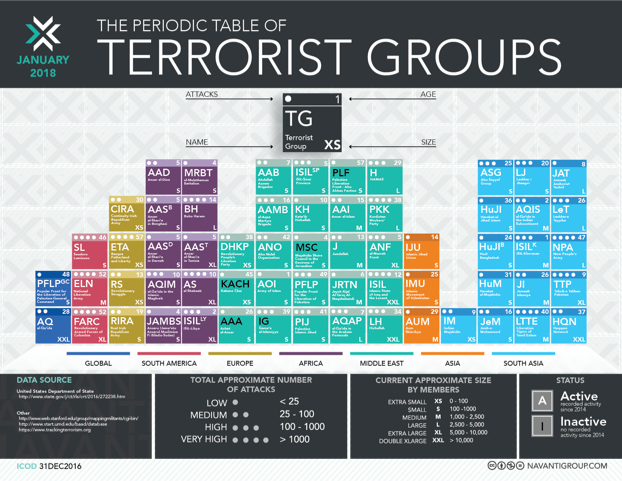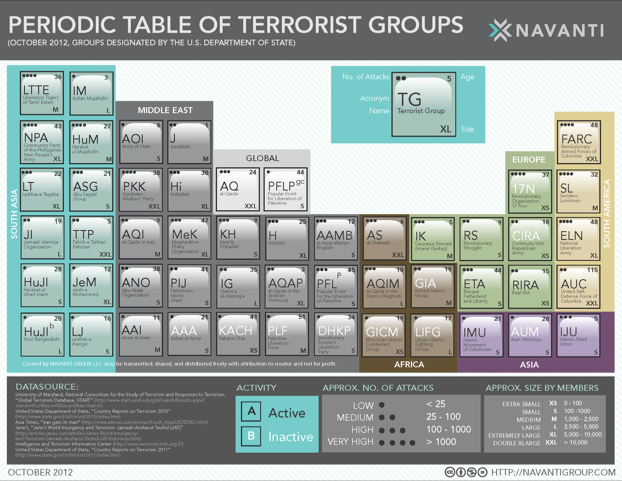Periodic Table
Periodic Table of Terrorist Groups
Navanti’s Periodic Table of Terrorist Groups provides a visualization of State Department’s list of designated Foreign Terrorist Organizations.
History
Originally designed in 2010 as a fun side project by our analysts, the Periodic Table has become popular among practitioners and academics as a useful visualization for the state of global terrorism. The Periodic Table received updates in 2012, 2014, 2018, 2019, and 2021 as it was augmented with up-to-date academic data.
Purpose
However you use the Periodic Table, we’d love to hear about it. Drop us a line at: info@navantigroup.com. In the last eight years, we’ve heard about the Periodic Table being used in undergraduate syllabi, figures in PhD dissertations, practitioner reference guides, as a hotly debated item on blogs and forums, and one famous example in a Business Insider article.
![Navanti_Periodic_MAR_2021_low[1].jpg](https://images.squarespace-cdn.com/content/v1/58ad9382579fb31cac16b9d3/1617738429713-XF8U8IK1O0526UIEP28U/Navanti_Periodic_MAR_2021_low%5B1%5D.jpg)
Navanti Periodic Table of Terrorist Groups – March 2021
The most significant change between 2019 and 2020 was the proliferation of violent extremist organizations (VEO) in Africa. Harakat Sawa’d Misr – also known as HASM – in Egypt, Islamic State of Iraq and Syria – Democratic Republic of the Congo (ISIS-DRC), and the Islamic State of Iraq and Syria – Mozambique (ISIS-Mozambique) were added to the Foreign Terrorist Organizations list under section 219 of the Immigration and Nationality Act, as amended. Additionally, The Middle East and South Asia experienced the most change in force size and number of attacks – most significantly, AQAP reduced the pace of their attacks on civilian and government targets.
![[NEW] - 2019 periodic_table_infographic_LITE.jpg](https://images.squarespace-cdn.com/content/v1/58ad9382579fb31cac16b9d3/1565021575859-4NSHB34OXFFGZWRQWP8U/%5BNEW%5D+-+2019+periodic_table_infographic_LITE.jpg)
Navanti Periodic Table of Terrorist Groups-August 2019
All previous references on the table to the Islamic State of Iraq and the Levant (ISIL) have been updated to the Islamic State of Iraq and Syria (ISIS) as the latter is now more conventional in State Department documentation. ISIS was added to the FTO list in 2004 and since then, the group’s influence has spread to many countries across the regions. Only one group (ANO) was removed from the previous table and eight were added to the list between 2017 and 2019 (Africa: ISIS-WA, ISIS-GS, & JNIM; Middle East: AAB*Bahrain & IRGC; South Asia: HM, ISIS-B, & ISIS-P). Two groups were changed to an inactive status (ETA – Europe and LTTE – South Asia). Notably, Hamas experienced growth in its membership, and increased attacks in the Gaza Strip between 2017 and 2018.

Navanti Periodic Table of Terrorist Groups-January 2018
The most significant change between 2014 and 2017 was the proliferation of the Islamic State (ISIL) and its affiliates in Africa, the Middle East, and South Asia, adding five of the thirteen new groups over the reporting period. The Middle East and South Asia also experienced the most change in force size and number of attacks, with AQAP, AUM, DHKP, H, Hi, IG, JAT, and KACH increasing. While eight groups in total reduced the pace of their attacks on civilian and government targets, eight others maintained the level of activity by increasing their attacks: AAD, AQAP, ETA, Hi, IM, JeM, LJ, and TTP.

Navanti Periodic Table of Terrorist Groups-September 2014
The design was stretched in 2014 as the total number of groups jumped to 61 designated FTOs. This is a 30% increase over the 2010 data set, with the Middle East growing to 23 and South Asia growing to 14 entities.

Navanti Periodic Table of Terrorist Groups-October 2012
The 2012 update showed the total number of designated FTOs grow to 51 worldwide, with the Middle East growing to 19 organizations.

Navanti Periodic Table of Terrorist Groups-October 2010
The original Periodic Table. This was our first attempt at organizing the FTO list and assigning values for group size and number of attacks. 47 groups in all, with 2 being considered Global.

